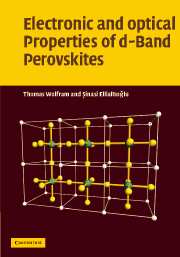Refine search
Actions for selected content:
106100 results in Materials Science
Using Bulk Heterojunction Field Effect Measurements to Understand Charge Transport in Solar Cell Materials
-
- Journal:
- MRS Online Proceedings Library Archive / Volume 1270 / 2010
- Published online by Cambridge University Press:
- 01 February 2011, 1270-GG10-02
- Print publication:
- 2010
-
- Article
- Export citation
Thermodynamic Modelling of the Pd-Te-Ru System for Nuclear Waste Glasses Application
-
- Journal:
- MRS Online Proceedings Library Archive / Volume 1265 / 2010
- Published online by Cambridge University Press:
- 01 February 2011, 1265-AA03-04
- Print publication:
- 2010
-
- Article
- Export citation
Wear Properties of an In-Situ Processed TiC-Reinforced Bronze
-
- Journal:
- MRS Online Proceedings Library Archive / Volume 1276 / 2010
- Published online by Cambridge University Press:
- 01 February 2011, 17
- Print publication:
- 2010
-
- Article
- Export citation
Photoelectron Spectroscopy of U Oxide at LLNL
-
- Journal:
- MRS Online Proceedings Library Archive / Volume 1264 / 2010
- Published online by Cambridge University Press:
- 01 February 2011, 1264-Z11-06
- Print publication:
- 2010
-
- Article
- Export citation
Electrically conductive composites via infiltration of single-walled carbon nanotube-based aerogels
-
- Journal:
- MRS Online Proceedings Library Archive / Volume 1258 / 2010
- Published online by Cambridge University Press:
- 01 February 2011, 1258-R05-31
- Print publication:
- 2010
-
- Article
- Export citation
Thermoelectric Properties of CoSb3-based Skutterudite Compounds
-
- Journal:
- MRS Online Proceedings Library Archive / Volume 1267 / 2010
- Published online by Cambridge University Press:
- 01 February 2011, 1267-DD03-02
- Print publication:
- 2010
-
- Article
- Export citation
EFM Study on Ge Island: Carrier Charge and Storage Effect
-
- Journal:
- MRS Online Proceedings Library Archive / Volume 1260 / 2010
- Published online by Cambridge University Press:
- 01 February 2011, 1260-T10-44
- Print publication:
- 2010
-
- Article
- Export citation
Quantitative approaches for characterising fibrillar protein nanostructures
-
- Journal:
- MRS Online Proceedings Library Archive / Volume 1274 / 2010
- Published online by Cambridge University Press:
- 01 February 2011, 1274-QQ04-05
- Print publication:
- 2010
-
- Article
- Export citation
Direct Measurement of Hot-spot Temperature in Flip-chip Solder Joints With Cu Columns Under Current Stressing using Infrared Microscopy
-
- Journal:
- MRS Online Proceedings Library Archive / Volume 1249 / 2010
- Published online by Cambridge University Press:
- 01 February 2011, 1249-F08-02
- Print publication:
- 2010
-
- Article
- Export citation
Vertical Aligned CNT Growth on Metals for Direct Use With Electrical Conductance
-
- Journal:
- MRS Online Proceedings Library Archive / Volume 1258 / 2010
- Published online by Cambridge University Press:
- 01 February 2011, 1258-R10-44
- Print publication:
- 2010
-
- Article
- Export citation
Systematic first principles calculations of the effects of stacking faults defects on the 4H-SiC band structure
-
- Journal:
- MRS Online Proceedings Library Archive / Volume 1246 / 2010
- Published online by Cambridge University Press:
- 01 February 2011, 1246-B03-07
- Print publication:
- 2010
-
- Article
- Export citation
Impact of Dopants on the PbTe Thermoelectric Efficiency
-
- Journal:
- MRS Online Proceedings Library Archive / Volume 1267 / 2010
- Published online by Cambridge University Press:
- 01 February 2011, 1267-DD05-19
- Print publication:
- 2010
-
- Article
- Export citation
Non-destructive Detection and Visualization of Extended Defects in 4H-SiC Epilayers
-
- Journal:
- MRS Online Proceedings Library Archive / Volume 1246 / 2010
- Published online by Cambridge University Press:
- 01 February 2011, 1246-B03-02
- Print publication:
- 2010
-
- Article
- Export citation
Atom Probe Tomography characterization of the microstructural evolution of a low copper reactor pressure vessel steel under neutron irradiation
-
- Journal:
- MRS Online Proceedings Library Archive / Volume 1264 / 2010
- Published online by Cambridge University Press:
- 01 February 2011, 1264-BB05-18
- Print publication:
- 2010
-
- Article
- Export citation
Nanoimprint Lithography with UV-Curable Hyperbranched Polymer Nanocomposites for Optical Biosensing Applications
-
- Journal:
- MRS Online Proceedings Library Archive / Volume 1253 / 2010
- Published online by Cambridge University Press:
- 01 February 2011, 1253-K11-03
- Print publication:
- 2010
-
- Article
- Export citation
Mechanisms of Ionic Transport in Membranes for Batteries and Fuel Cells
-
- Journal:
- MRS Online Proceedings Library Archive / Volume 1269 / 2010
- Published online by Cambridge University Press:
- 01 February 2011, 1269-FF03-06
- Print publication:
- 2010
-
- Article
- Export citation
Controlling the Physical Properties of Random Network Based Shape Memory Polymer Foams
-
- Journal:
- MRS Online Proceedings Library Archive / Volume 1274 / 2010
- Published online by Cambridge University Press:
- 01 February 2011, 1274-QQ05-01
- Print publication:
- 2010
-
- Article
- Export citation
Growth, Characterization and Comparisons of Few-layer Boron Nitride Nanosheets and Graphene
-
- Journal:
- MRS Online Proceedings Library Archive / Volume 1259 / 2010
- Published online by Cambridge University Press:
- 01 February 2011, 1259-S14-10
- Print publication:
- 2010
-
- Article
- Export citation
High Quality, Low Bandgap a-Si Films and Devices Produced Using Chemical Annealing
-
- Journal:
- MRS Online Proceedings Library Archive / Volume 1245 / 2010
- Published online by Cambridge University Press:
- 01 February 2011, 1245-A04-03
- Print publication:
- 2010
-
- Article
- Export citation

Electronic and Optical Properties of d-Band Perovskites
-
- Published online:
- 23 December 2009
- Print publication:
- 05 October 2006
